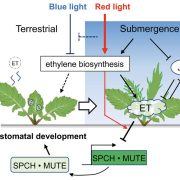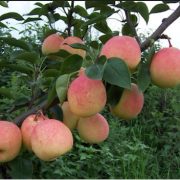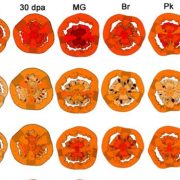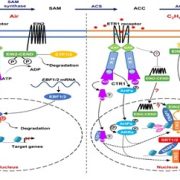A Rosy Scenario for Flower Opening
By Chengchen Xia, Junping Gao, and Nan Ma
Background: Flowers are unique structures in angiosperms that are used for reproduction. Proper flower opening is crucial for attracting pollinators and is pivotal for successful pollination. In general, flower opening is driven by the coordinated development and movements of floral organs, particularly petals. Time-lapse photography has shown that the movement of rose petals follows a smooth and continuous path, with outward movements at the petal base and a curvature towards the petal tops during opening. Many studies have shown that the gaseous phytohormone ethylene accelerates petal movement and flower opening in roses (Rosa hybrida).
Question: How does ethylene trigger the directional movement of petals?
Findings: Unexpectedly, we found that cell expansion-dependent growth of the adaxial side of the petal base, rather than expansion of the petal lamina, drives petal movement in rose. Ethylene accelerates petal movement by enhancing this asymmetric growth of the adaxial side of the petal base. PETAL MOVEMENT-RELATED PROTEIN1 (RhPMP1), a homeodomain transcription factor, is responsible for the asymmetric growth of the petal base during flower opening. RhPMP1 directly binds to the promoter of ANAPHASE-PROMOTING COMPLEX 3b (RhAPC3b), encoding a central player in cell endoreduplication. Both RhPMP1 and RhAPC3b are specifically induced by ethylene in the adaxial side of the petal base. Knockdown of either RhPMP1 or RhAPC3b impaired the ethylene-induced asymmetric growth of the petal base and petal movement.
Next steps: This work supports the notion that ethylene specifically activates a certain regulatory cascade (RhPMP1-RhAPC3b) in the adaxial (but not abaxial) side of the petal bases of rose flowers. Considering the gaseous nature of ethylene, an interesting question is whether, and how, cell identity determines this unique response in the petal base.
Chenxia Cheng, Qin Yu, Yaru Wang, Hong Wang, Yuhan Dong, Yuqi Ji, Xiaofeng Zhou, Yonghong Li, Cai-Zhong Jiang, Su-Sheng Gan, Liangjun Zhao, Zhangjun Fei, Junping Gao, Nan Ma (2021). Ethylene-regulated asymmetric growth of the petal base promotes flower opening in rose (Rosa hybrida). Plant Cell https://doi.org/10.1093/plcell/koab031










